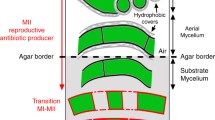Summary
Electron microscopic observations of vegetative cell division inLabyrinthula indicate that the specialized invaginations of the cell surface called bothrosomes arisede novo between newly divided daughter cells and function in the production of the membrane-bound extracellular matrix or slimeways. Protocentrioles are formed before each division and persist through cell separation but are not found in interphase cells. Cytokinesis begins after the completion of mitosis and occurs by vesicle accumulation and fusion, an unusual cytokinetic mechanism reminiscent of zoospore cleavage. Cell elongation after cytokinesis is accompanied by elongation of the Golgi apparatus and the appearance of non-spindle microtubules.
Similar content being viewed by others
References
Allen, R. D., 1969: The morphogenesis of basal bodies and accessory structures of the cortex of the ciliated protozoanTetrahymena pyriformis. J. Cell Biol.40, 716–733.
Aschner, M., andS. Kogan, 1959: Observations on the growth ofLabyrinthula macrocystis. Bull. Res. Council Israel8 D, 15–24.
Bartsch, G., 1971: Cytologische Beobachtungen anLabyrinthula coenocystis Schmoller bei verschiedenen Kulturbedingungen. Z. allg. Mikrobiol.11, 79–90.
Bonner, J. T., 1967: The Cellular Slime Molds. 2nd Ed. 205 pp. Princeton, N. J.: Princeton Univ. Press.
Brinkley, B. R., P. Murphy, andL. C. Richardson, 1967: Procedure for embeddingin situ selected cells culturedin vitro. J. Cell Biol.35, 279–283.
Byers, B., andK. R. Porter, 1964: Oriented microtubules in elongating cells of the developing lens rudiment after induction. Proc. nat. Acad. Sci. (U.S.A.)52, 1091–1099.
Chlapowski, F. J., andR. N. Band, 1971: Assembly of lipids into membranes inAcanthamoeba palestinensis II. The origin and fate of glycerol-3H-labeled phospholipids of cellular membranes. J. Cell Biol.50, 634–651.
Cienkowski, L., 1867: Über den Bau und die Entwicklung der Labyrinthuleen. Schultzes Arch. Mikroskop. Anat.3, 274–310.
Darley, W. M., andM. S. Fuller, 1970: Cell wall chemistry and taxonomic position ofSchizochytrium. Amer. J. Bot.57, 761.
Gay, J. L., andA. D. Greenwood, 1966: Structural aspects of zoospore production inSaprolegnia ferax with particular reference to the cell and vesicular membranes. Colston Papers18, 95–110.
—,I. B. Heath, andA. D. Greenwood, 1971: The formation and behavior of vacuoles (vesicles) during oosphere development and zoospore germination inSaprolegnia. J. Gen. Microbiol.65, 233–241.
Heath, I. B., andA. D. Greenwood, 1970 a: The structure and formation of lomasomes. J. Gen. Microbiol.62, 129–137.
— —, 1970 b: Centriole replication and nuclear division inSaprolegnia. J. Gen. Microbiol.62, 139–148.
Heintz, C. E., 1970: Zoosporogenesis inPythium middletonii. Amer. J. Bot.57, 760.
Hohl, H., 1966: The fine structure of the slimeways inLabyrinthula. J. Protozool.13, 41–43.
Hollande, A., etM. Enjumet, 1955: Sur l'évolution et la systématique des Labyrinthulidae; étude deLabyrinthula algeriensis nov. sp. Ann. Sci. Nat., Zool., 11me ser.17, 357–368.
Jepps, M. W., 1931: Note on a marineLabyrinthula. J. Mar. Biol. Ass.17 (N.S.), 833–838.
Klie, H., undF. Mach, 1968: Licht- und elektronenmikroskopische Untersuchungen über die Wirkung von Labyrinthula-Enzymen auf Bakterien- und Hefezellen. Z. allg. Mikrobiol.8, 385–395.
—, undW. Schwartz, 1963: Untersuchungen über Lebensweise und Kultur vonLabyrinthula. Z. allg. Microbiol.3, 15–24.
Lessie, P. E., andJ. S. Lovett, 1968: Ultrastructural changes during sporangium formation and zoospore differentiation inBlastocladiella emersonii. Amer. J. Bot.55, 220–236.
Luft, J. H., 1961: Improvements in epoxy resin embedding methods. J. Biophys. Biochem. Cytol.9, 409–415.
Nozawa, Y., andG. A. Thompson, Jr., 1971: Studies of membrane formation inTetrahymena pyriformis. III. Lipid incorporation into various cellular membranes of logarithmic phase cultures. J. Cell Biol.49, 722–730.
Ohad, I., P. Siekevitz, andG. E. Palade, 1967: Biogenesis of chloroplast membranes. II. Plastid differentiation during greening of a dark-grown algal mutant (Chlamydomonas reinhardi). J. Cell Biol.35, 553–583.
Olive, L. S., 1970: TheMycetozoa: a revised classification. Bot. Rev.36, 59–89.
Omura, T., P. Siekevitz, andG. E. Palade, 1967: Turnover of constituents of the endoplasmic reticulum membranes of rat hepatocytes. J. Biol. Chem.242, 2389–2396.
Perkins, F. O., 1970: Formation of centriole and centriole-like structures during meiosis and mitosis inLabyrinthula sp. (Rhizopodea, Labyrinthulida). J. Cell Sci.6, 629–653.
- 1971: Monocentric biflagellate fungi of Chesapeake Bay, Virginia: Ultrastructure and taxonomy. 1st Int. Mycol. Cong. Abstracts,74.
—, andJ. P. Amon, 1969: Zoosporulation inLabyrinthula sp.; an electron microscope study. J. Protozool.16, 235–257.
Pickett-Heaps, J. D., 1969: The evolution of the mitotic apparatus: an attempt at comparative ultrastructural cytology in dividing plant cells. Cytobios3, 257–280.
—, 1970 a: Mitosis and autospore formation in the green algaKirchneriella lunaris. Protoplasma70, 325–347.
—, 1970 b: Some ultrastructural features ofVolvox, with particular reference to the phenomenon of inversion. Planta (Berl.)90, 174–190.
—, 1971: The autonomy of the centriole: fact or fallacy? Cytobios12, 205–214.
Pokorny, K., 1967:Labyrinthula. J. Protozool.14, 697–708.
Porter, D., 1967: Observations on the cytology and motility ofLabyrinthula. 139 pp. Ph. D. Thesis, Univ. Washington.
—, 1969: Ultrastructure ofLabyrinthula. Protoplasma67, 1–19.
Schmoller, H., 1960: Kultur und Entwicklung vonLabyrinthula coenocystis n. sp. Arch. Mikrobiol.36, 365–372.
Stey, H., 1968: Nachweis eines bisher unbekannten Organells beiLabyrinthula. Z. Naturforsch.23 b, 567.
—, 1969: Elektronenmikroskopische Untersuchung anLabyrinthula coenoeystis Schmoller. Z. Zellforsch.102, 387–418.
Szubinska, B., 1971: “New membrane” formation inAmoeba proteus upon injury of individual cells. J. Cell Biol.49, 747–772.
Tilney, L. G., andJ. R. Gibbins, 1969: Microtubules in the formation and development of the primary mesenchyme inArbacia punctulata. II. An experimental analysis of their role in development and maintenance of cell shape. J. Cell Biol.41, 227–250.
Valkanov, A., 1929: Protistenstudien 4. Die Natur und die systematische Stellung der Labyrinthuleen. Arch. Protistenk.67, 110–212.
Watson, S. W., 1957: Cultural and cytological studies on species ofLabyrinthula. 165 pp. Ph. D. Thesis, Univ. Wisconsin.
—, andK. B. Raper, 1957:Labyrinthula minuta sp. nov. J. Gen. Microbiol.17, 368–377.
Young, E. L., 1943: Studies onLabyrinthula. The etiologic agent of the wasting disease of eel-grass. Amer. J. Bot.30, 586–593.
Zopf, W., 1892: Zur Kenntnis der Labyrinthuleen, einer Familie der Mycetozoen. Beitr. Physiol. Morph. niederer Organismen2, 36–48.
Author information
Authors and Affiliations
Rights and permissions
About this article
Cite this article
Porter, D. Cell division in the marine slime mold,Labyrinthula sp., and the role of the bothrosome in extracellular membrane production. Protoplasma 74, 427–448 (1972). https://doi.org/10.1007/BF01281960
Received:
Issue Date:
DOI: https://doi.org/10.1007/BF01281960




